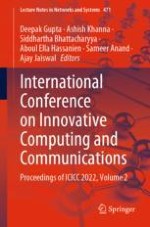2023 | Buch
International Conference on Innovative Computing and Communications
Proceedings of ICICC 2022, Volume 2
herausgegeben von: Deepak Gupta, Ashish Khanna, Siddhartha Bhattacharyya, Aboul Ella Hassanien, Sameer Anand, Ajay Jaiswal
Verlag: Springer Nature Singapore
Buchreihe : Lecture Notes in Networks and Systems
